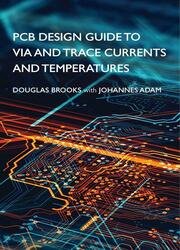PCB Design Guide to Via and Trace Currents and Temperatures
- Добавил: literator
- Дата: 31-05-2021, 17:37
- Комментариев: 0
 Название: PCB Design Guide to Via and Trace Currents and Temperatures
Название: PCB Design Guide to Via and Trace Currents and TemperaturesАвтор:Douglas Brooks, Johannes Adam
Издательство: Artech House
Год: 2021
Страниц: 293
Язык: английский
Формат: pdf (true)
Размер: 10.1 MB
Printed circuit board designers have lots of things to think about. Typically, the first is just connecting the dots. Then, how to do so on the minimum number of layers. Then, there are all the signal integrity issues to deal with. And then, finally, how do we size the few power traces there are for carrying the required current?
This latter question constitutes only a very small fraction of the total job. But it can be the most mysterious, in part because there aren’t many reliable guidelines to work from. Then, many of the guidelines that exist are incomplete, contradictory, or, even worse, flat wrong. This book is intended to cover the entire topic of the relationship between PCB trace and via current/temperature relationships.
It covers:
- The theories behind the various aspects of the topic;
- The results of simulations based on those theories;
- In several cases, summaries of experimental results based on, and confirming, the simulations.
A very important part of printed circuit board (PCB) design involves sizing traces and vias to carry the required current. This exciting new book will explore how hot traces and vias should be and what board, circuit, design, and environmental parameters are the most important. PCB materials (copper and dielectrics) and the role they play in the heating and cooling of traces are covered. The IPC curves found in IPC 2152, the equations that fit those curves and computer simulations that fit those curves and equations are detailed.
Sensitivity analyses that show what happens when environments are varied, including adjacent traces and planes, changing trace lengths, and thermal gradients are presented. Via temperatures and what determines them are explored, along with fusing issues and what happens when traces are overloaded. Voltage drops across traces and vias, the thermal effects going around right-angle corners, and frequency effects are covered. Readers learn how to measure the thermal conductivity of dielectrics and how to measure the resistivity of copper traces and why many prior attempts to do so have been doomed to failure. Industrial CT Scanning, and whether or not they might replace microsections for measuring trace parameters are also considered.
Скачать PCB Design Guide to Via and Trace Currents and Temperatures
Внимание
Уважаемый посетитель, Вы зашли на сайт как незарегистрированный пользователь.
Мы рекомендуем Вам зарегистрироваться либо войти на сайт под своим именем.
Уважаемый посетитель, Вы зашли на сайт как незарегистрированный пользователь.
Мы рекомендуем Вам зарегистрироваться либо войти на сайт под своим именем.
Информация
Посетители, находящиеся в группе Гости, не могут оставлять комментарии к данной публикации.
Посетители, находящиеся в группе Гости, не могут оставлять комментарии к данной публикации.
